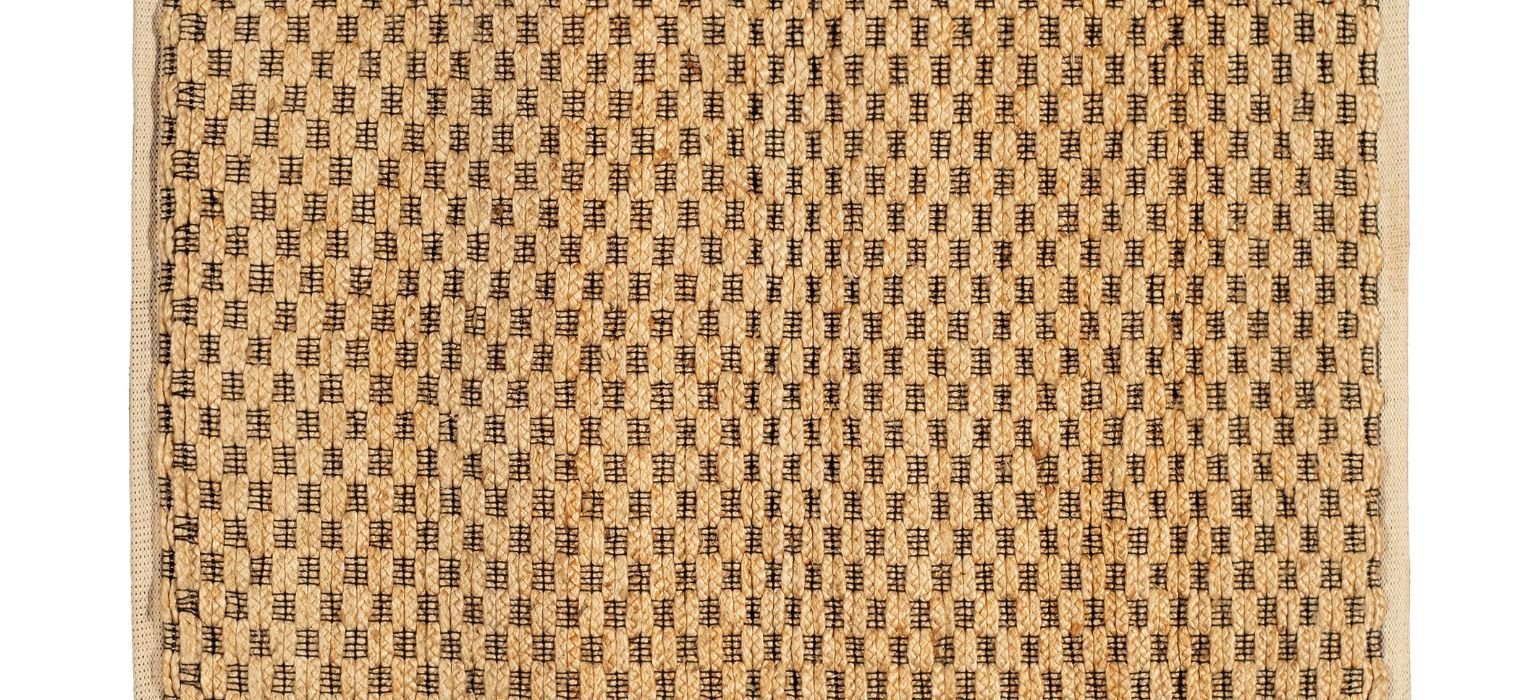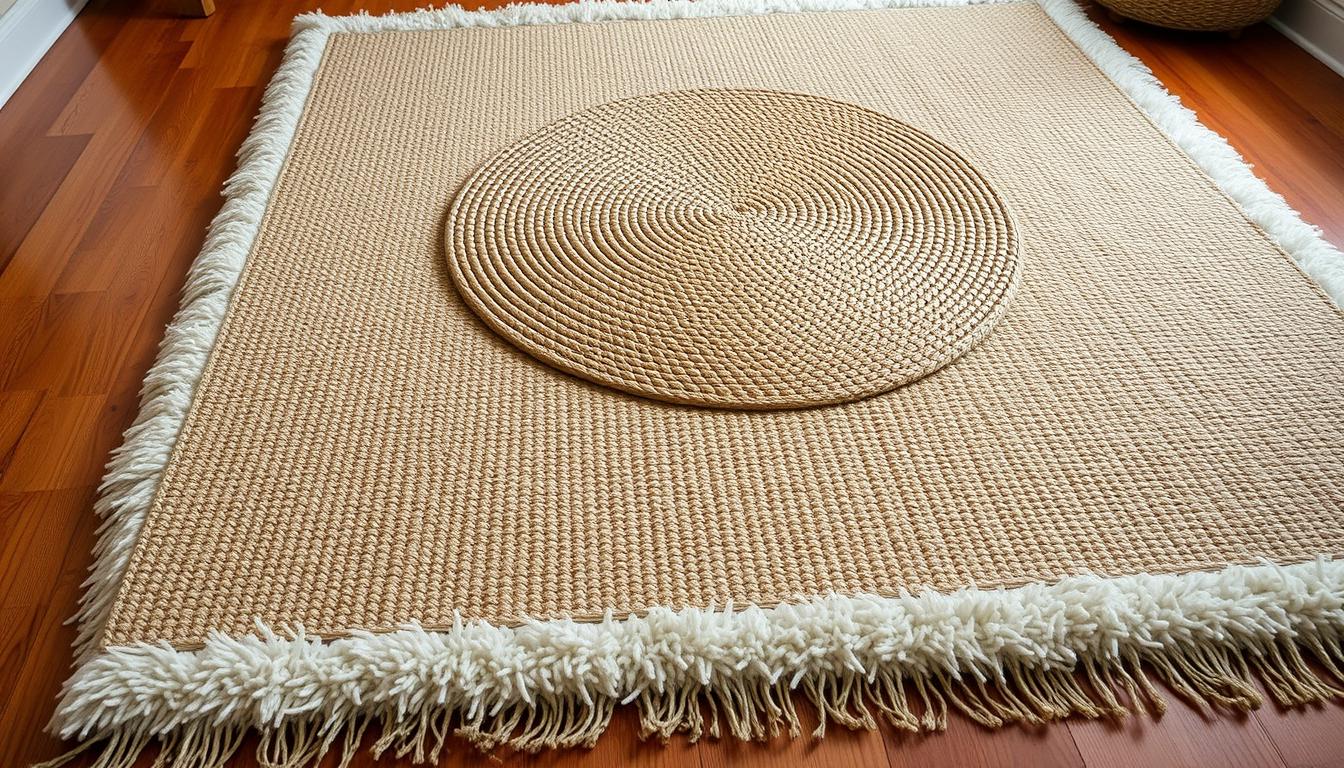
7 Steps to Clean Pet Stains from Jute Rugs
Ever wondered why your favorite natural fiber floor covering struggles to bounce back after a pet accident? Unlike synthetic materials, jute’s absorbent nature makes it uniquely vulnerable to moisture and odors. This creates a frustrating dilemma: how do you tackle messes without ruining the rug’s earthy charm?

At Braided-Rugs.com, we’ve seen firsthand how improper methods lead to discoloration or mold in these eco-friendly textiles. Pet accidents demand swift action, but harsh cleaners or vigorous scrubbing can weaken fibers permanently. The solution lies in balancing urgency with gentle care.
This guide reveals a 7-step process using household staples like vinegar and baking soda. You’ll learn why blotting—not rubbing—is critical and how to neutralize odors that linger beneath the surface. For tougher cases, like specific solutions for urine accidents, targeted approaches preserve your rug’s integrity.
Key Takeaways
- Natural fibers like jute require delicate handling to avoid permanent damage.
- Immediate moisture control prevents stains from setting deep into the material.
- Eco-friendly solutions protect both your home and pets from harsh chemicals.
- Traditional steam cleaning or aggressive scrubbing can distort jute’s texture.
- Proper techniques extend your rug’s lifespan while maintaining its organic appeal.
Understanding Jute Rugs and Pet Stains
Natural fiber floor coverings bring warmth to any room, but their delicate structure demands special attention when accidents happen. Jute’s organic charm comes with unique maintenance challenges that synthetic alternatives don’t face.
Properties and Benefits of Jute Rugs
Woven from plant-based materials, these textiles offer three standout qualities:
- Eco-conscious durability: Lasts years without harming the environment
- Breathable texture: Allows air circulation while resisting static
- Neutral aesthetic: Blends seamlessly with modern and traditional decor
"Jute’s porous fibers act like microscopic sponges—they’ll soak up liquids faster than you can grab a towel."
Why Pet Stains Are Problematic
Animal accidents create a perfect storm for natural materials. Urine penetrates deep into the fiber matrix, carrying enzymes that break down plant-based structures over time. Within minutes, spills can seep through multiple layers, spreading discoloration.
Harsh cleaners worsen the issue by weakening jute’s natural binders. This leads to fraying edges or permanent dullness. For targeted solutions for urine accidents, pH-balanced approaches work best to neutralize odors without damaging fibers.
Immediate Actions After Pet Accidents
Quick response is your best ally against lasting damage in natural textiles. When accidents occur, your approach determines whether fibers retain their integrity or develop permanent marks.

Proper Blotting and Moisture Control
Grab white paper towels or microfiber cloths immediately. Press firmly—don’t scrub—to lift liquids upward. This prevents contaminants from spreading into the weave.
Start at the stain’s outer edge, moving inward. Flip the textile if needed to address trapped dampness beneath. Swap soaked materials frequently to maintain absorption power.
Key mistake to avoid: Rubbing creates friction that weakens strands. Gentle pressure preserves texture while pulling moisture out. For stubborn cases like urine penetration, specialized pH-neutral treatments work without harsh chemicals.
Check for lingering dampness by pressing a dry cloth against the spot. If moisture transfers, repeat blotting until the area feels crisp. Airflow accelerates drying—use fans or open windows if possible.
Assess the damage once the surface dries. Light discoloration might need simple refreshers, while deeper saturation requires targeted solutions. Early intervention stops organic matter from bonding with fibers permanently.
Effective Techniques: how to clean jute rug pet stain
Natural textiles demand smart approaches when addressing organic spills. Two proven techniques balance effectiveness with fiber preservation—one harnessing acidic properties, the other leveraging gentle surfactants.
Acidic Neutralization Approach
Combine equal parts white vinegar and cold distilled water in a spray bottle. Lightly mist affected areas without soaking through. Wait five minutes as the solution breaks down proteins while deodorizing.
Follow with a baking soda sprinkle to absorb residual moisture. This dual-action method tackles both visible marks and hidden odors. Always test mixtures on hidden rug sections first.
Surfactant-Based Treatment
Create a mild cleaner using three drops of clear dish soap per cup of chilled water. Dab sparingly with a microfiber cloth, moving from stain edges toward the center. Rinse with a damp cloth and blot dry immediately.
| Method | Ingredients | Best For | Drying Time |
|---|---|---|---|
| Vinegar Blend | White vinegar + water | Fresh accidents | 2-3 hours |
| Soap Solution | Dish soap + water | Set-in marks | 1-2 hours |
Both approaches prevent enzymatic bonding—the main cause of recurring smells. For persistent odors, consider specialized odor removal solutions designed for plant-based fibers. Remember: less liquid preserves texture better than heavy saturation.
Step-by-Step Guide to Clean Your Jute Rug
Effective maintenance of plant-based textiles follows a methodical approach. Proper technique preserves both appearance and structural integrity while addressing organic residues thoroughly.

Detailed 7-Step Cleaning Process
Begin by blotting spills immediately using white cloths. Assess the affected zone to choose between vinegar solutions or mild soap mixtures. Apply your selected cleaner sparingly, letting it sit for 5-10 minutes to break down particles.
Blot again to lift dissolved contaminants. While the surface remains slightly damp, distribute baking soda evenly across the treatment zone. This powder works overnight to absorb trapped moisture and neutralize odors at their source.
Complete the process by vacuuming meticulously with a soft brush attachment. This final action restores texture while removing all residue. For persistent smells, consider specialized odor-neutralizing solutions designed for delicate fibers.
Blending Techniques for Best Results
Combine sequential methods for comprehensive care. Alternate between moisture extraction and powder applications to address multiple stain layers. Allow each stage adequate time before progressing—rushing risks incomplete odor removal.
Always test mixtures on hidden sections first. Monitor drying phases closely, using fans to accelerate airflow if needed. Strategic method blending ensures lasting freshness without compromising natural material integrity.
Using Natural Cleaners and Home Remedies
Your kitchen holds secret weapons for preserving natural textiles. Everyday ingredients offer surprising power against organic messes while keeping fibers intact.
Eco-Friendly and Natural Options
Club soda becomes your first responder for fresh spills. Its bubbles push stains upward when dabbed gently with microfiber cloths. For deeper issues, baking soda works overnight to absorb odors—just sprinkle, wait, and vacuum.
Mix white vinegar with cold water (1:1 ratio) to break down stubborn residues. This acidic duo neutralizes alkaline messes without harsh chemicals. "Cold water preserves fiber structure better than hot," notes a textile conservator we consulted.
Try these four pantry staples:
- Lemon-salt paste: Citric acid tackles discoloration with gentle abrasion
- Cornstarch: Absorbs oily marks in 3-4 hours
- Talcum powder: Lifts grease from delicate weaves
- Essential oils: Add 2 drops to baking soda for fresh scents
For persistent smells, specialized odor-neutralizing treatments target deep-set issues. These home products protect both your family and the planet—no toxic residues left behind.
Always test mixtures on hidden areas first. Gentle approaches maintain the earthy charm of plant-based floor coverings better than industrial cleaners. With the right techniques, your natural textile stays vibrant for years.
Preventing Future Stains on Your Jute Rug
Safeguarding your natural fiber floor covering starts with smart prevention strategies. Three layered approaches keep fibers intact while reducing accident risks—without sacrificing style.
Strategic Barriers and Maintenance
Washable pads act as sacrificial layers in high-traffic zones. These removable shields catch spills before they reach delicate weaves. Pair them with targeted cleaning solutions for complete protection.
Train pets gently using scent-marked mats near edges. This redirects behavior while preserving your rug’s neutral aesthetic. Trim claws monthly to prevent snags that loosen fibers.
Natural repellent sprays form invisible shields against moisture. Apply every six months to maintain liquid resistance. For stubborn smells, odor-neutralizing treatments tackle deep-set issues without harsh chemicals.
Regular vacuuming removes dirt that weakens strands over time. Rotate floor coverings seasonally to distribute wear evenly. With these steps, your textile stays fresh while weathering daily life gracefully.
FAQ
Can natural fiber rugs handle liquid spills effectively?
While durable, natural fibers like jute absorb moisture quickly. Immediate blotting is critical to prevent permanent damage from liquids. Avoid rubbing, as it pushes spills deeper into the material.
What makes vinegar useful for odor removal?
White vinegar neutralizes ammonia in urine, eliminating lingering odors without harsh chemicals. Mix equal parts water and vinegar, apply lightly, and let sit for 10 minutes before blotting dry.
Are commercial cleaners safe for plant-based materials?
Many contain chemicals that weaken or discolor natural fibers. Opt for mild dish soap diluted in water or eco-friendly solutions to preserve texture and color.
How does baking soda assist in stain treatment?
Sprinkling baking soda absorbs excess moisture and neutralizes smells. Let it sit for 30 minutes before vacuuming. For tougher stains, combine it with vinegar for a gentle foaming action.
Why is direct sunlight recommended after cleaning?
Sunlight dries residual moisture and naturally disinfects fibers. Avoid prolonged exposure, as UV rays can fade colors over time. Rotate the rug evenly during drying.
Can protective sprays prevent future accidents?
Yes, fabric protectors create a barrier against spills and stains. Choose non-toxic, breathable formulas to maintain the rug’s natural feel while repelling liquids.
What’s the risk of using excessive water during cleaning?
Over-wetting causes shrinkage, warping, or mold growth. Always use minimal moisture and blot thoroughly. A fan or dehumidifier speeds up drying in humid environments.









